The months of June and July 2019 witnessed four significant events which are a portent for the future of UK carrier aviation.
The thirty-seventh anniversary of the Argentine surrender marking the end of the Falklands War was commemorated on the 14th of June. Exactly two days later Royal Air Force F-35B Lightning aircraft operating from RAF Akrotiri in Cyprus completed their first armed overwatch mission over Syria marking their operational debut in UK service.
This article was submitted to the UK Defence Journal by Kelvin Curnow. Kelvin’s particular area of interest is naval aircraft and aircraft carriers. He is a keen writer and over the past fifteen years he has had a number of articles published in different journals.
Denoting a significant step towards initial operating capability, on the 17th of June HMS QUEEN ELIZABETH sailed from Portsmouth for a final round of sea trials before departing for the USA in Autumn for the next round of trials with the F-35B. The final and ominous event occurred on the 20th of July with the seizure of the British flagged tanker Stena Impero by Iran’s Islamic Revolutionary Guard Corps (IRCG) in the Strait of Hormuz using fast inshore patrol craft.
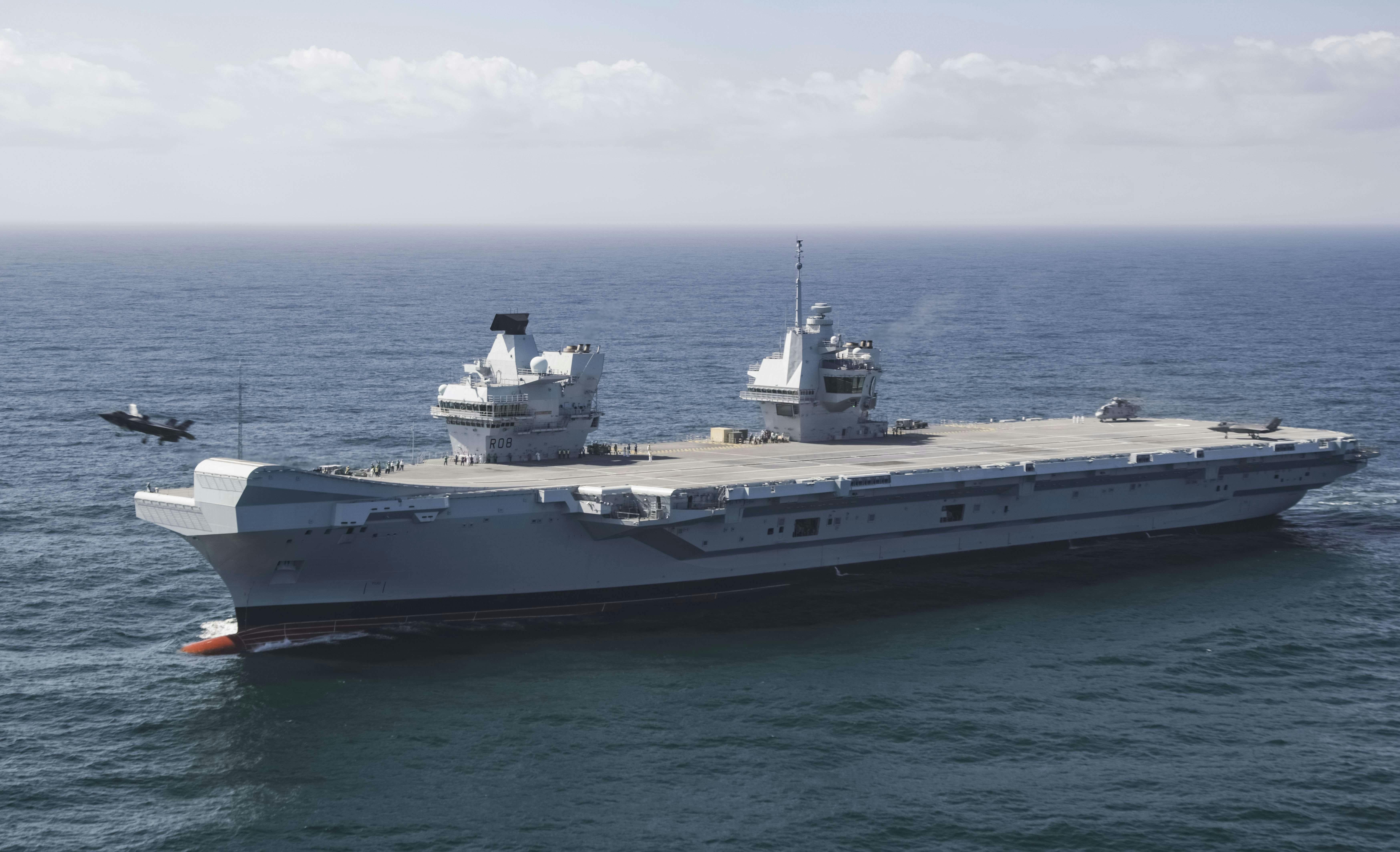
The successful prosecution of the Falklands War lies in stark contrast to the ease with which the Iranians captured the British tanker and marks the steep decline in Britain’s maritime capabilities. Regeneration of the UK’s naval capability is marked by the construction of HMS QUEEN ELIZABETH and HMS PRINCE OF WALES (PoW) – collectively designated the QUEEN ELIZABETH CLASS (QEC).
BUILDING A CARRIER FORCE – CATOBAR OR STOVL?
In the light of lessons acquired from the Falklands conflict and both Gulf Wars it became apparent that vessels larger than the Invincible class light carriers would be needed to successfully prosecute any future conflict.
The decision to build two large aircraft carriers also took into account that future aircraft would be larger and heavier and would require a sizeable flight deck for their efficient operation. Before settling on the QEC design one of the alternatives considered was a 40,000 ton carrier configured for Catapult Assisted Take Off But Arrested Recovery (CATOBAR) operation. With respect to this proposal it is pertinent to consider the French Navy’s 42,500 ton FS CHARLES DE GAULLE (CdG).

Particularly telling are photographs of the CdG participating in Exercise Fanal 2019. These demonstrate both the strengths and weaknesses of the design. The carrier’s strengths are immediately obvious. Arrayed on the flight deck are thirty Dassault Rafale M fighters, two Northrop Grumman E-2C Airborne Early Warning And Control (AEW&C) aircraft, and two helicopters. Also evident are the 4 × 8 cell A-43 Sylver launchers for the MBDA Aster 15 surface-to-air missile (SAM). However, despite this apparent imposing impression of both offensive and defensive firepower limitations of the design are also evident. Carrying a mix of thirty-four aircraft and helicopters the flight deck is decidedly crowded, a fact which restricts the launch and recovery cycle and the refuelling and re-arming of aircraft.
Moreover, while the CdG is inherently advantaged given that it is a CATOBAR design, the carrier’s size means that it equipped with two 75m C13‑3 steam catapults, a shorter stroke version of the catapults installed on the substantially larger USN supercarriers. As aircraft weights inevitably rise, these catapults will prove inadequate and questions have already arisen concerning the suitability of the CdG for F-35C operations. Another factor weighing against a 40,000 ton CATOBAR design was the RN’s experience in the Falklands War.
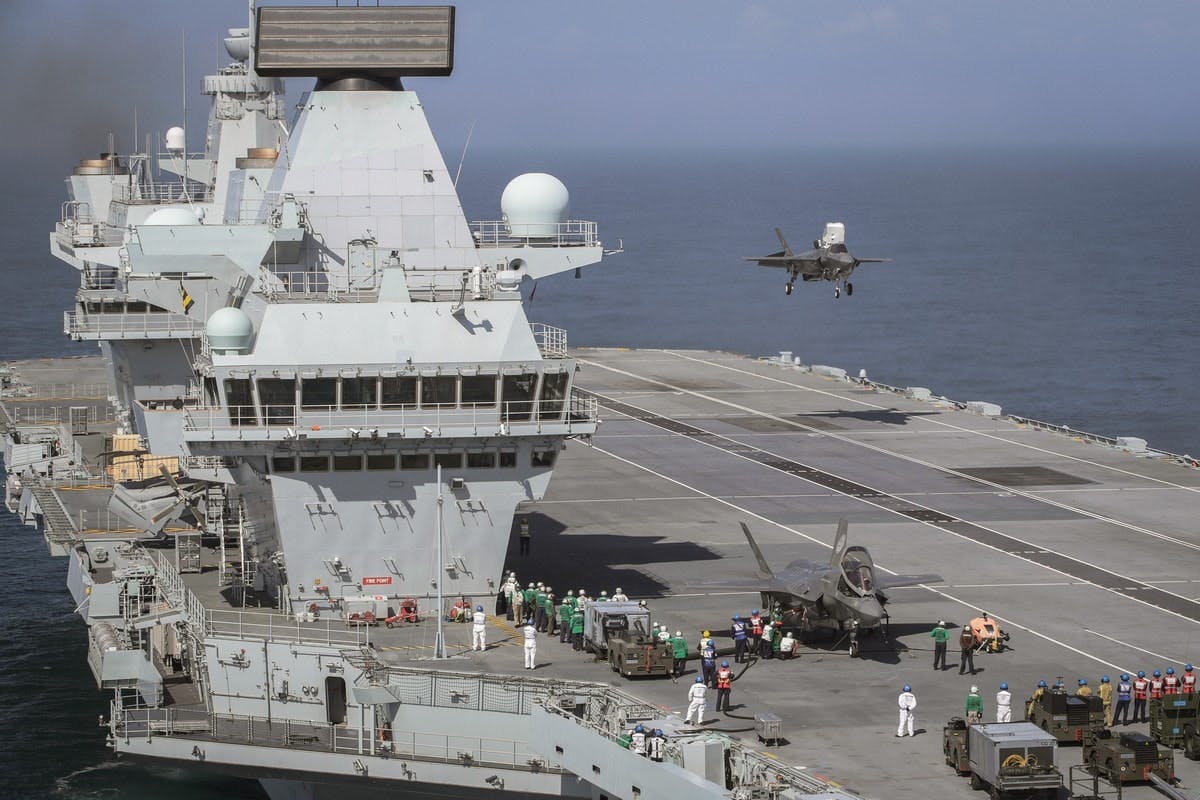
Arguments have surrounded the outcome of the war had the CATOBAR equipped HMS ARK ROYAL been available. Larger than the CdG and carrying an equivalent air wing, on paper the capabilities provided by the ship far outstripped those of HMS HERMES and HMS INVINCIBLE. However, given the appalling weather conditions in the South Atlantic and the poor availability rate of the Phantoms and Buccaneers its impact on the outcome remains debatable. The experience of successfully operating Harrier aircraft, despite the weather and high sea states, demonstrated the flexibility of carriers configured for the operation of Short Take-Off and Vertical Landing (STOVL) aircraft. Additionally, HERMES was decidedly overcrowded carrying a mix of twenty-one Sea Harriers and Harriers plus helicopters, but remained fully operational principally because she was a STOVL carrier.
On the 25th of July 2007, the then Defence Secretary Des Browne, announced the order for two new carriers. This was preceded by a December 2006 statement that the UK’s intention was that it would acquire 138 F-35Bs designed for STOVL operation. In May 2010 the Cameron government announced that the Prince of Wales (PoW) would be converted to Catapult Assisted Take Off But Arrested Landing (CATOBAR) configuration, a plan abandoned in May 2012 after it had been determined that the cost of the modification would be over £1BN.
Being an all-electric ship the PoW would have been equipped with the Electromagnetic Aircraft Launch System (EMALS) and the Advanced Arresting Gear (AAG).
These have had significant problems, described by the Office of the Director of Operational Test and Evaluation in January 2019 as suffering from ‘poor or unknown reliability’. In hindsight, given that the F-35C will not be operational on all USN aircraft carriers until 2027 the UK’s decision to persist with the F-35B now appears sensible, particularly in light of the fact that both the RAF and United States Marine Corps (USMC) have undertaken combat operations with this variant. The latter flew one hundred missions against both the Taliban and ISIS, many of them kinetic.
THE AIR WING
The F-35 is a fifth generation low observable aircraft which operates as a ‘system of systems’ using its open architecture software, avionics, integrated electronic sensors, displays and communications systems to collect data and present it in a ‘fused’ form to the pilot.
The data can also be automatically shared via secured datalinks, the Multifunction Advanced Data Link (MADL) and Link 16, with external platforms such as a Typhoon or Type 45 destroyer. The primary sensor, the Northrop-Grumman AN/APG-81 active electronically scanned array (AESA) radar has a maximum tracking range of 250km (135nm) for an airborne target of one square metre Radar Cross Section (RCS) and a maximum detection range of 400km (216nm) with the radar in search mode. The radar can identify and track 23 targets in 9 seconds while engaging 19 of them in 2.4 seconds.
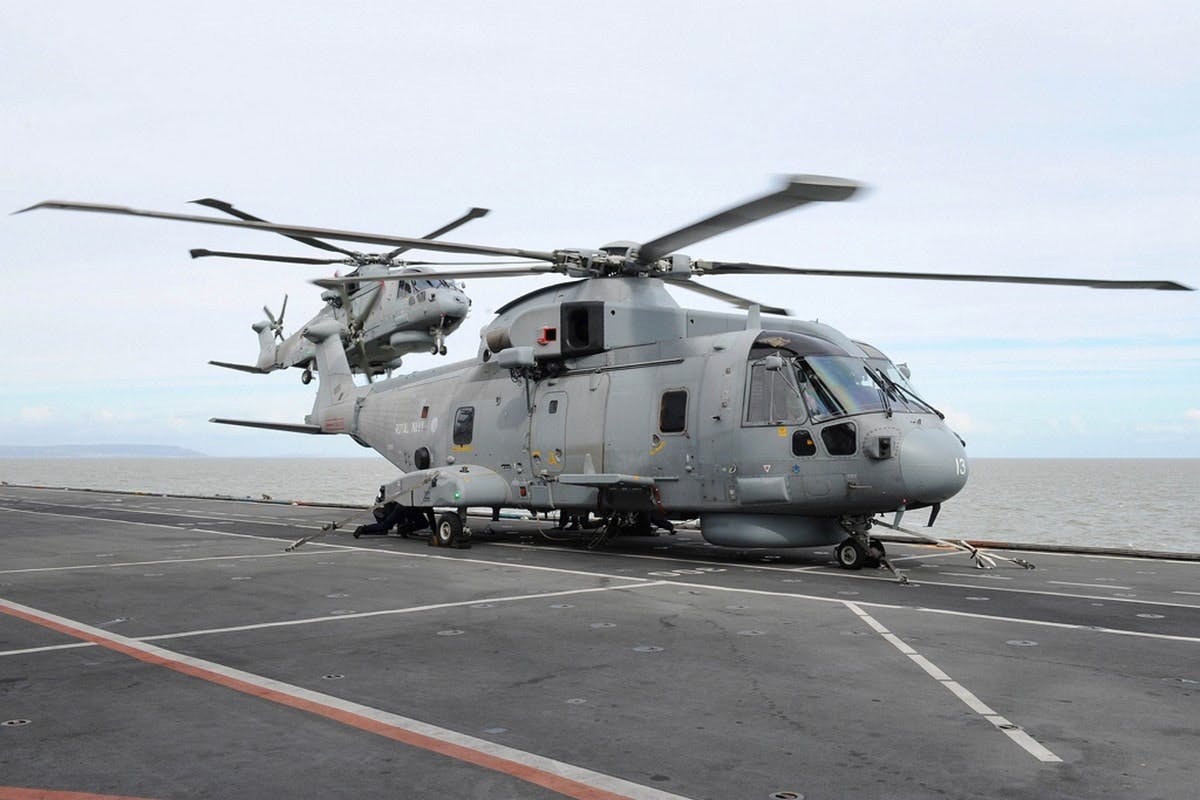 The radar operates together with the Electro-Optical Targeting System (EOTS), the AN/ASQ-239 Barracuda electronic warfare suite and the Northrop Grumman electro-optical AN/AAQ-37 Distributed Aperture System (DAS) to provide the aircraft with 360 degrees situational awareness (SA). The DAS has six sensors distributed over the aircraft which act as a missile warning system, report missile launch locations, detect and track approaching aircraft, and it also replaces traditional Night Vision Goggles (NVGs).
The radar operates together with the Electro-Optical Targeting System (EOTS), the AN/ASQ-239 Barracuda electronic warfare suite and the Northrop Grumman electro-optical AN/AAQ-37 Distributed Aperture System (DAS) to provide the aircraft with 360 degrees situational awareness (SA). The DAS has six sensors distributed over the aircraft which act as a missile warning system, report missile launch locations, detect and track approaching aircraft, and it also replaces traditional Night Vision Goggles (NVGs).
Demonstrating a unique capability, a DAS sensor mounted in a test platform detected a two-stage ballistic missile launch 1,300 kilometres away. The radar can operate in the electronic attack mode, the electronic warfare suite having proved capable of detecting and jamming radars, including the F-22’s extremely sophisticated AN/APG-77.
Demonstrating yet another unique capacity the aircraft can operate as non-traditional intelligence, surveillance, target acquisition, and reconnaissance (ISTAR) platform. Its capabilities were demonstrated in early 2017 by an Israeli F-35I Adir which gathered new intelligence during a single flight that other reconnaissance and intelligence gathering systems would have taken weeks to gather. Together, therefore, the F-35B is more than the sum of all its parts and its capabilities outweigh anything found in any previous fighter.
With the small numbers of F-35s available these factors are critical.

The Leonardo HM2 Merlin is the other main offensive/defensive component of the carrier air wing (CVW). Learning from the lack of Airborne Early Warning (AEW) in the Falklands conflict, five Merlins will provide Airborne Surveillance and Control (ASaC).
The Crowsnest system consists of the Thales Searchwater 2000 Radar which has a range of 150nm (278km) and can track 400 targets simultaneously and the Cerberus mission system which can monitor 600 tracks simultaneously. These figures are an improvement over those of the Sea King ASaC7 but pale in relation to the 300+nm (556km) radar range of the Lockheed Martin AN/APY-9 radar fitted to the Northrop Grumman E-2D Hawkeye.
However, the Merlin will be supplemented in its ASaC role by the F-35’s AN/APG-81 radar, which via secure data links will provide a comprehensive radar picture out to a greater range. In addition to the ASaC Merlins, an additional eight Anti-Submarine Warfare (ASW) HM2s will be part of the CVW. Merlins in RN service are not utilised to their full potential in comparison to those of the Italian Navy Aviation (Aviazione Navale) which in addition to the ASW role uses it in the Anti-Surface Warfare (ASuW) role.
With a radius of action of 450nm (834km), extendable by Helicopter In-Flight Refuelling (HIFR), and carrying two MBDA Marte ER 54+nm (100+km) range missiles, the Merlin would have a very effective means of attacking both ships and land targets at extended range.
This is an extremely useful capability given the potentially small numbers of F-35s available.
DEFENDING THE QUEEN ELIZABETH CLASS
Given experience in the Falklands War, when an inordinate amount of resources were committed to preventing a successful attack on HERMES and INVINCIBLE by Exocet missiles fired from Super Étendards the lack of weapons for self-defence mounted on the QEC is, in my personal view, a grievous oversight. They carry three Phalanx Close-In Weapons Systems (CIWS), a totally inadequate defensive capability particularly given the development of supersonic, hypersonic and ballistic missiles.
The addition of the ‘Sea Ceptor’ would provide a self-defence capability against ‘leakers’ which penetrate the air defence umbrella provided by the goalkeeper destroyers and frigates.
The Sea Ceptor has inherent qualities: it is already in RN service; it requires no dedicated tracking radar only cueing from the Artisan radar with which the QEC is already equipped; and, it is cold-launched by a compressed air-driven piston before the rocket motor ignites minimising the effect from smoke and toxic fumes.
The RN has recently (July 2016) successfully trialled the similar Thales Martlet Lightweight Multi-role Missile (LMM) fired from a five missile mounting attached to a DS30M Mark 2 remotely operated 30mm cannon turret fitted to HMS SUTHERLAND.

The QEC have four of these mountings. Fitted with both HVM and LMM, the latter available with both laser and infra-red guidance, would provide the carriers with a high degree of anti-air and anti-surface capability, especially if they are to be operated in the confines of the Persian Gulf or the Arabian Sea where threats are posed by drones and fast inshore attack craft operated by the IRCG.
Another defensive layer could be provided via electronic attack. The effectiveness of an electronic warfare and directed energy weapon was demonstrated when on 18 July 2019 the USMC’s Light Marine Air Defense Integrated System (LMADIS) mounted on the USS BOXER brought down an Iranian drone.
THE QEC AT WAR
Consecutive UK governments have overseen the drastic reduction in the number of warships available to the Royal Navy largely based on an assumption that the UK’s armed forces could rely on its NATO allies should a serious conflict break out. In such circumstances it could be assumed that an Royal Navy carrier would be operating as part of a larger allied taskforce.
As an indication of such operations, on the QE’s first operational deployment to the Pacific she will carry a mix of British and US F-35s and be accompanied by a Dutch air warfare destroyer.
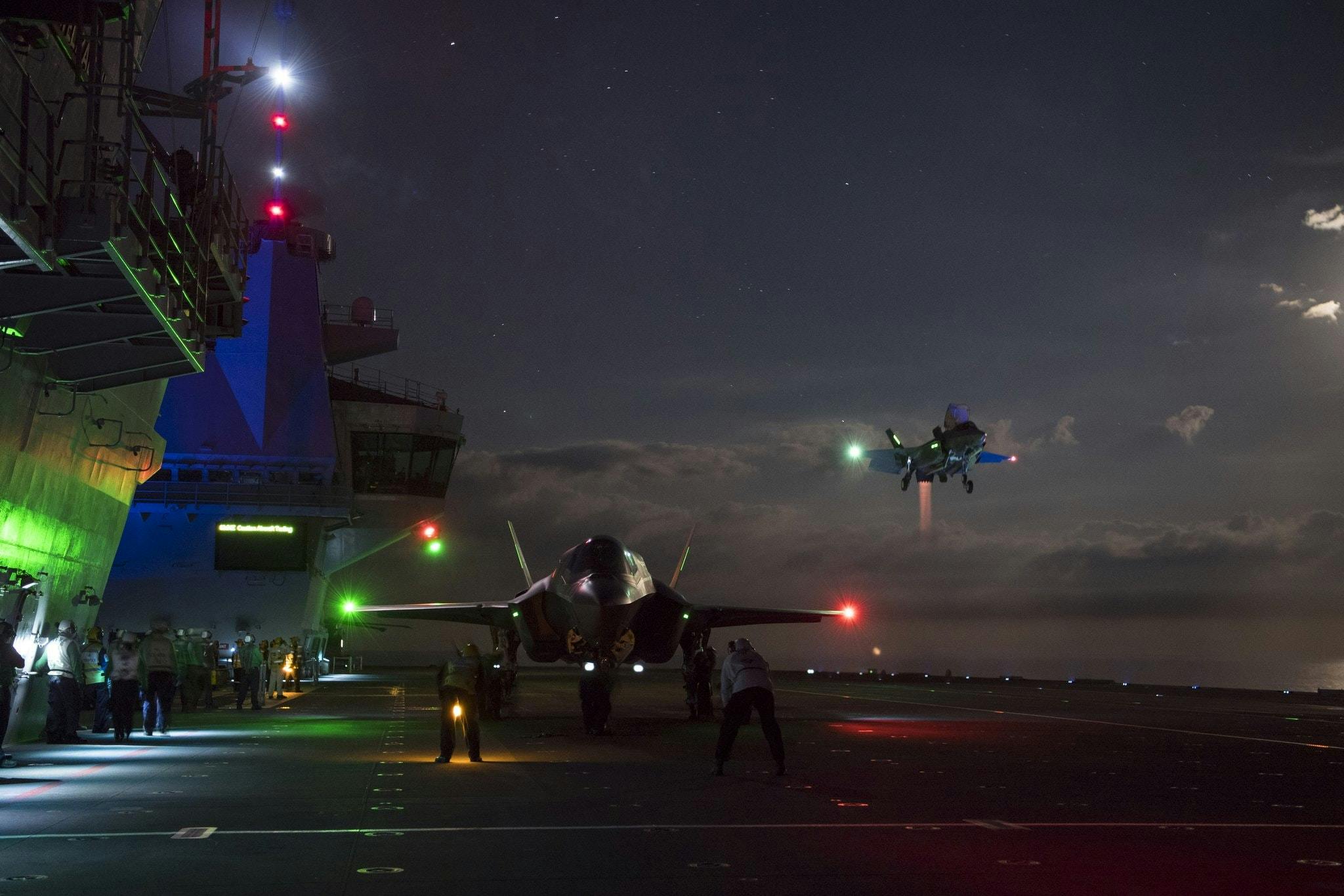
However, it cannot be assumed that the UK will have the support of the US in any future conflict given the current trend of that nation’s non-interventionist policies, or policies which prioritise US interests over those of its allies. Reflecting this stance and speaking in respect to the seizure of the Stena Impero, the US Secretary of State said on 22 July 2019 that ‘The responsibility in the first instance falls to the United Kingdom to take care of their ships’.
An instance where the UK’s armed forces were required to operate with minimal support from the US was the NATO led 23 March – 31 October 2011 intervention in Libya in which the principal responsibility for airstrikes fell to France and the UK.
This was an intervention for which the RN was ill prepared, largely due to the Cameron government’s short-sighted 2010 Strategic Defence and Security Review (SDSR) decision to withdraw the Harrier GR9/9As from service, thus depriving the navy of any carrier strike capability.

The only strike capability available to the UK came by way of five British Army Apache AH1 helicopters operating off HMS OCEAN. The Apaches flew 22 missions for a total of 49 combat sorties. In contrast the Italian Navy Aviation (Aviazione Navale) deployed eight AV-8B Harrier IIs on the light carrier ITS GIUSSEPE GARIBALDI.
These carried out armed reconnaissance sorties using LITENING targeting pods while armed with AIM-120 AMRAAMs and AIM-9 Sidewinders and dropped 160 precision-guided bombs during 418 sorties and 1,221 flight hours. The other carrier deployed was the CdG.
It operated with an air wing which included ten Rafale and six Super Étendard Modernisé (SEM) fighters and gives an insight into what capability could have been provided had one QEC carrier been available. By August 4 2011, of the 6745 sorties flown by NATO aircraft France had flown 2225, over half of them coming from CdG. The CdG’s air wing conducted a total of 1,350 missions comprising 840 strike, 390 Rafale reconnaissance, 120 Hawkeye AEW&C and 240 buddy refuelling sorties.
These figures are important to understanding the QEC carriers’ capacity to contribute to an air campaign because both the British and French carriers are designed to generate the same number of sorties per day.
Additionally, despite the usual derisory note adopted by commentators with respect to reality that the QEC class will have a normal complement of twelve F-35Bs, the impressive figures achieved by the CdG’s air wing demonstrates that the number of aircraft on board is not the only determinant to the CVW’s effectiveness. Both the RN and MN place an emphasis on the number of sorties generated rather than the number of aircraft in the CVW.
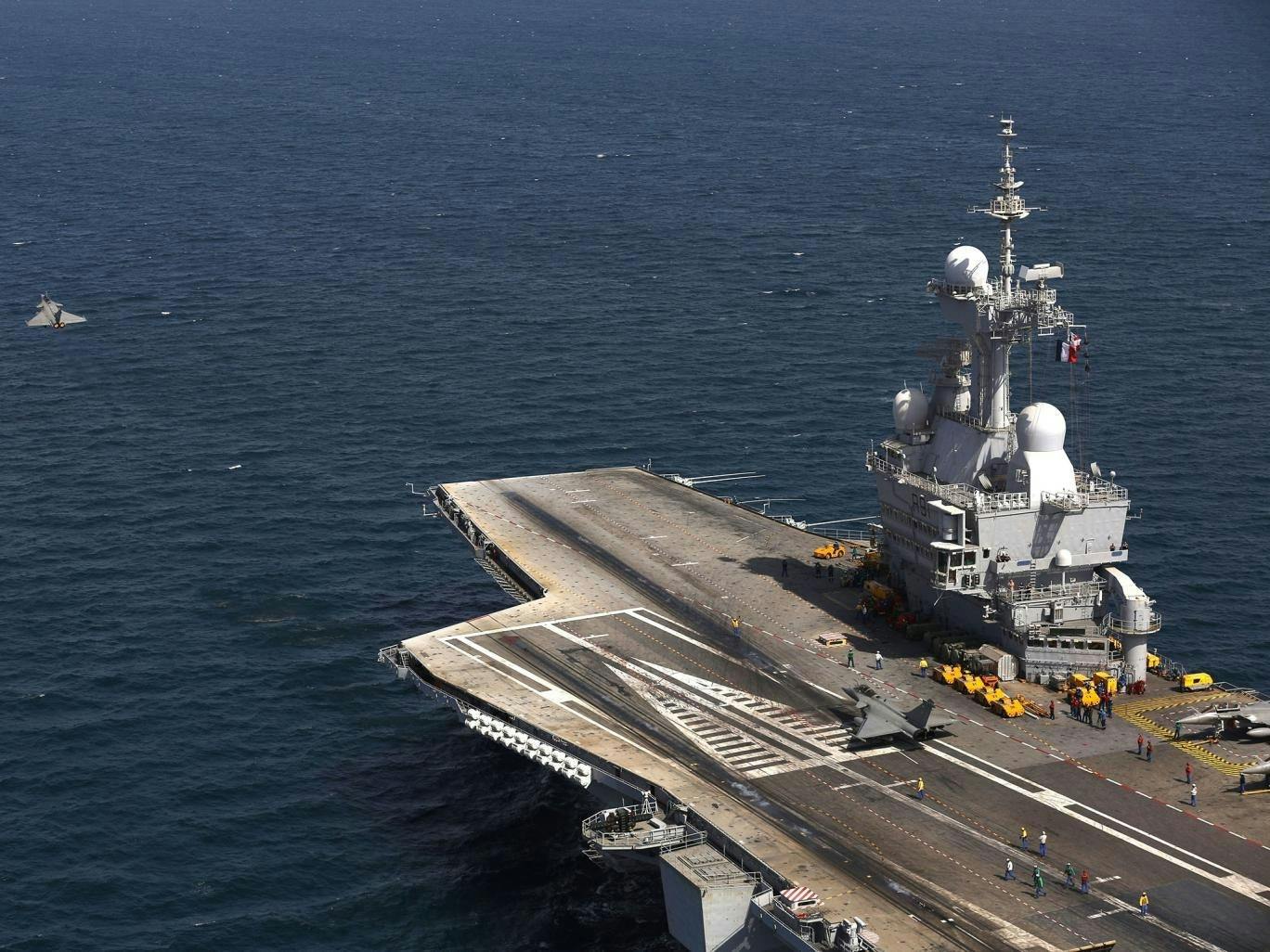
The GdG’s planes flew 3,600 hours in theatre with an average flight time of 2 hours and 20 mins. In contrast, aircraft flying from Gioia del Colle flew 90 minutes before reaching Libya’s coast, while the RAF’s initial strikes flown from RAF Marham involved an eight hour 3,000mi (4,800km) round trip relying on four air-to-air refuelling brackets. The ability of carrier-borne aircraft to generate a greater proportion of missions and a superior Time Over Target (TOT) was thus demonstrated again.
The folly of disbanding the UK’s Harrier force demonstrated that the lessons of the Falklands War had been forgotten. In contrast to the Libyan operation where a ‘carrier strike’ capability managed to generate only 22 Apache missions in 1982 the RN’s Sea Harrier’s (SHAR) were able to generate an exceptional mission rate, a critical factor given the few aircraft available. A total of 1,435 combat sorties were flown during the 45 days of air combat operations beginning 1 May 1982. Having an availability rate of over 90% each SHAR flew an average of 1.41 sorties per day.

During the Falklands conflict the SHARs attained air superiority shooting down twenty Argentine aircraft for no loss (a kill-loss ratio only bettered by the F-15 Eagle). The RN was ill equipped for the Falklands conflict yet was required to unilaterally engage in the only Air-Sea war fought since World War II. The task force possessed only twenty SHARs at the start of the conflict, augmented later by a further eight SHARs and fourteen RAF Harrier GR3s. This number of aircraft proved insufficient to provide total air superiority.
While of a magnitude greater in capability than the first-generation Harriers thirty-six F-35s is an inadequate number to undertake all the missions required if either the QE or PoW was committed to a peer or near peer conflict. This reality is exacerbated by the UK’s slow F-35 buy-rate which will see only forty-eight available by 2025, barely enough to equip one CVW.
If thirty-six F-35s were available, the CARRIER would rely on generating a maximum 110 sortie rate per day or up to 420 sorties over five days to compensate for the low numbers. These ambitious figures could only come by way of repeating the 95% availability rate achieved by the six Lightnings deployed to Cyprus over the six week period from 21 May 2019.
Given current tensions in the Persian Gulf it is worthwhile assessing any role a QEC carrier could have, particularly given that commentators have criticised the RN for concentrating on procuring high end assets rather than destroyers and frigates. Operation Corporate to retake the Falklands would not have been possible without carrier airpower, conversely an aircraft carrier is not a suitable vessel for escorting tankers through the Straits of Hormuz. However, the carrier can provide a presence and capabilities not available via the deployed escort ships. The CSG can provide armed overwatch of British ships sailing in the Gulf. In the absence of a large number of escorts the Merlins could rappel Royal Marines on to ships should they come under threat. Support from F-35s would be an overwhelming deterrence to any threat to British flagged vessels.
No other asset can react as effectively and proportionately to any asymmetric threat from IRCG fast patrol craft through to ballistic missiles. Given their proliferation in the Gulf region, the F-35’s DAS ability to detect ballistic missiles designed to take out a carrier would be crucial in providing data linked information to Type 45 destroyers equipped with Aster 30 Block 1NT and Block 2BMD anti-ballistic missile missiles.
CONCLUSION
The Royal Navy has learnt the costly lessons of the Falklands conflict, but unfortunately has not applied them all. The F-35B Lightning is a fighter far beyond the capabilities offered by the SHAR. With more available aircraft equipped with Meteor AAMs sustained combat air patrols (CAPs) and even total air dominance are possibilities not available in the Falklands War. Moreover, the QEC carriers will have Merlin ASAC helicopters on board, a capability missing in 1982.
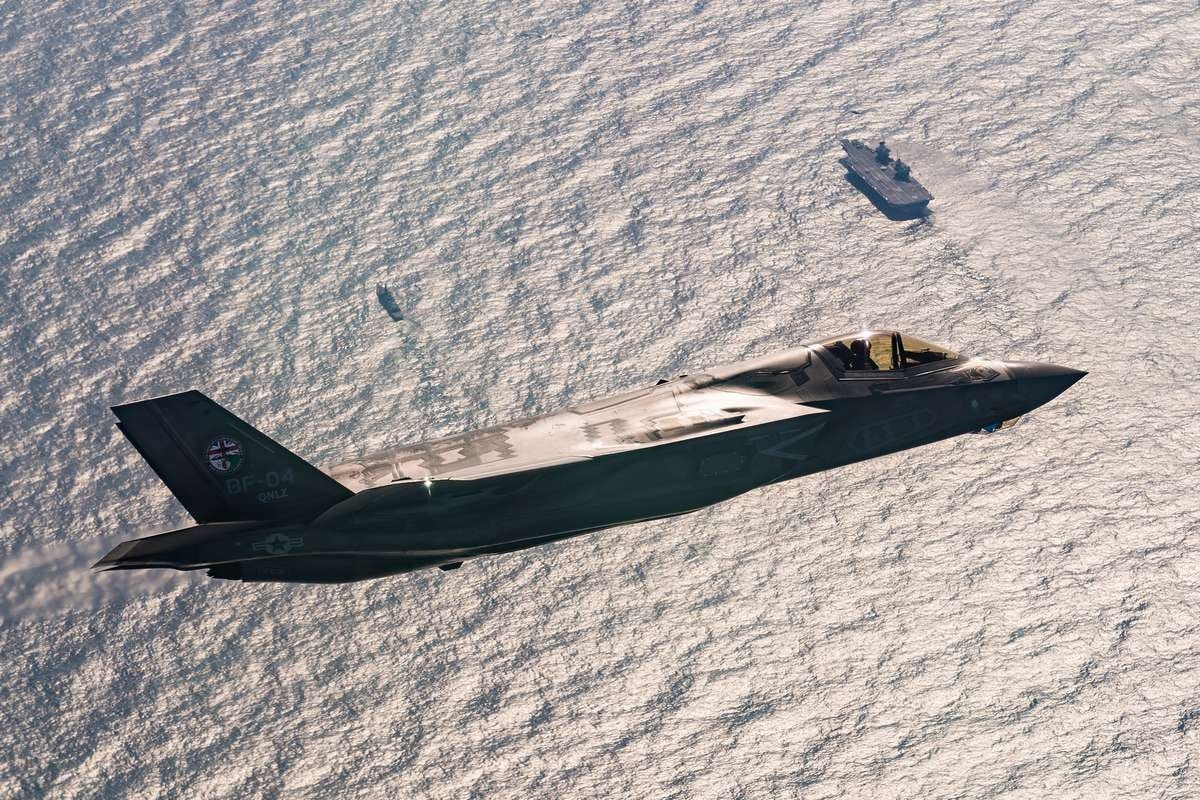
However, despite these achievements in re-generating big carrier aviation some capabilities are decidedly lacking, particularly in the area of insufficient defensive weapons.
This needs to be addressed by examining whether the carriers are equipped with an adequate number of self-defence weapons systems.



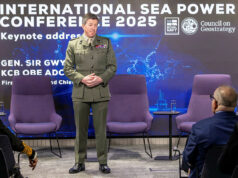
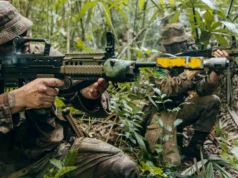

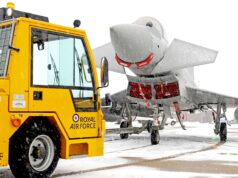
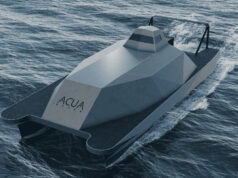
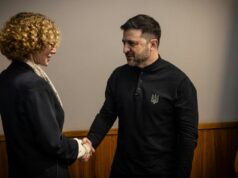



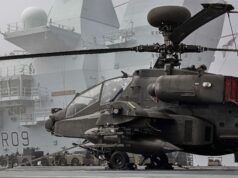

Well written and informative thank you
I enjoyed reading your comments, thanks.
It would be interesting to read a reply to this article from a serving Admiral.
A very interesting read. Thanks.
Re CdG & Libya…
“The GdG’s planes flew 3,600 hours in theatre with an average flight time of 2 hours and 20 mins”
… How would an F-35B handle an average flight time of 2 hours 20 mins? Would that be achievable on a single internal fuel load following the sort of flight profile seen in the Libya campaign or would augmentation (drop tanks and/or AAR) be needed?
I ask because the reduced range of the F-35B vs the A and C variants is often mentioned as an issue so I’m trying to put that into context.
The Rafale on internal fuel (4700kg) and a typical air to air load is said to have a range of just under 1000nm, The F35B’s published range is greater than 900nm. Therefore the F35B’s endurance will not be quite as long as the Rafale. However, the F35’s mission profile will be different for a Libyan type scenario. The aircraft will be operating in a medium to high altitude profile, to make best use of its sensors as it can rely on its stealthy features to remain unseen. The Rafale, although with a smallish RCS has to be more cautious.
The sortie generation and turnaround of the F35B will have to be higher, as it must either find a AAR tanker or return to the carrier for juice. As seen from the published data, the F35B’s range on internal fuel is a closely guarded secret. However, when looking at the fuel loads compared to the A and C versions which have 8,160kg and 8,160kg respectfully. The B version has only 6,800kg compared to its brothers, yet uses more fuel to get there, due to its less aerodynamic shape/thirstier engine. The ranges for the A and C are said to be greater than 1200nm. Therefore, overall the F35B will operate on a different flight profile than the Rafale. It will stay up high, so it’s endurance will be close to the Rafale. It will need to find fuel quicker and if only the internal bays are used carry less weapons.
Very good read, thanks a lot!
If possible, additional article on “what kind of logistic fleet will be needed for CVTF” will be something interesting for me.
As SDSR2020 is coming soon, and logistics are sometimes facing immediate cuts, this kind of analysis will be very helpful, if possible.
The carrier’s could be fitted with modern upgrade harriers to supplement the f35 giving a mix and more air assets
Training new Harrier pilots and mechanics would cost so much and take ages why not put the money into more F35s. Unless we use old Harrier crews. But The Harrier can only fly half the speed of the F35b and the F35s a game changer in terms of its electronics and capability’s and the range of the Harrier is shorter also and the weapons load is far less, the F35b can carry 10 ton of weapons when it uses external hard points 10 tons! Harrier certainly cant do that. I love the Harrier and miss it but sadly it’s day in the RN has gone! Time to look to the future m8.
i was annoyed everytime i hear about the USMC continuing to use the harrier until 2028 surely a new version of the harrier could have been designed and the u.k would already have sufficient aircraft for 2-3 squadrons retiring ark royal a full 5 years before its due date was indefensible the sight of the qe sailing into portsmouth with 50 odd fighters on deck would have looked spectacular lacking speed an payload ability is a design issue that british boffins could and would, have addressed.and we would have already had them, the sale of 72 aircraft for less the price of 1 f 35 working out at around 2 million or so each we keep hearing about money constraints in defense spending, but the constant questionable decision making makes you wonder how do these people get their jobs? a habit of selling the family jewels,such as the sales of the type 22’s for prices of a decent second hand car. is another thing the t22 was years ahead of its peers and ships had not done ‘big miles’ when sold.6 are still active around the world with brazil,chile and romania(buy them back?)redesignate as destroyers looking at the admiralty constantly banging on about not enough destroyers the type 22 was eminently feasible for the role a type 22 now, with artisan and sea ceptor, would be a formidable vessel indeed. and we’d have had lots of them!
What advantage would an upgraded harrier have over the f35? None!!!! the f35b is the direct development of the harrier.
Well if we had keep them, it would have given us the numbers to run a full air wing of two squadrons or surge to 36 airframe, as its its going to be a long wait.
Common sense says you don’t throw away the old until the new has arrived. But that bird has flown and there would no point in buying such old airframes.
its sad that it KEEPS HAPPENING.
cost, and the fact THEY WERE BUILT.
can’t understand, what are you on about?
BAEs doesn’t support the Harrier airframe anymore…. as they removed the operational support. so only airframes under there hours can fly, few SHARS and a T2 would be able to fly without manufacturer support like AKA The Vulcan….so we would have to buy a 60 year old design from Boeing that means mid life of the carriers QE Class would have a plane design 100 years old…..PMSL…
The Harrier’s day in the British military is over. There’s no way they would ever bring them back. Would be like the USN bring back Tomcat. Those days are gone.
Why didn’t we use STOBAR for our Carriers it’s much cheaper than CATOBAR and no need for complicated STOVL aircraft. All that’s basically needed is an arrestor wire ad blast shield. Then we could have got the f35c. Has anyone done any research and cost analysis of STOBAR I would love to look at it.
STOBAR was studied intensively, at the start of the Future Carrier (CVF) program, in conjunction with a proposed Sea Typhoon variant. It was rejected quickly because of the inherent failings of STOBAR. These are principally that it combines the worst aspects of CATOBAR and STOVL.
Without a catapult an aircraft is limited in its maximum takeoff weight. That means a limit on onboard fuel and weapons. It also means complexity in operations and a need to keep up a trained pool of pilots who are deck qualified to make arrested landings. The Russians found out the hard way how difficult it is to keep a group of pilots like that together. Apparently they got down to having just three or so pilots rated to fly off their STOBAR deck at one point.
So with STOVL we get the same limits on aircraft as STOBAR but operations from the ship are very simple – in 1982 RAF Harriers flew out to the RN task force and landed on them without ever having flown from the ship before. This allows us to deploy RAF aircraft and people to the ship to back up the navy squadrons. It also allows for a very much cheaper ship having no need for arresting gear.
maybe a new arrestor based around the emals concept.
No need for that had we, the RN, needed it. McTaggart Scott was, as recently as a few years ago, still offering the DAX-2 arresting engine design that was set to equip the last of our carrier designs.
This gear was more advanced, lighter and compact than the equivalent US equipment. Had an arresting system been needed we had one that was as good as anything else out there.
Because STOBAR is the option that provides the least capable aircraft.
Obviously catapulted aircraft can carry the greatest load, and V/STOL fighters can generate additional lift to allow greater takeoff weights. STOBAR aircraft don’t have either of those advantages, they’re just marinised conventional aircraft taking off from a very short space with no aid except a ramp, thus they’re forced to carry a very light load of weapons and fuel. STOBAR is cheap, but that’s the only advantage it offers.
The only evidence you need: neither the US or the UK (the countries responsible for the vast majority of naval aviation development) have gone with STOBAR, unless you count pre WWII designs with prop aircraft. It’s an inferior option.
You didnt read the article did you
It’s crazy how our type 45 destroyers have two phalanx CIWS and our aircraft carriers only have 3!
Buts that’s why we have the T45, to provide that exact capability, why spend more precious money on carrier defences, when you have the Ferrari of all Destroyers to its job of protecting the carrier. I understand a 4 CWIS can be fitted to the QE, I might well be before it’s 2021 deployment ?
It only needs 3 for 360 coverage. If you wish to improve point defence further install some Sea Ceptors.
Rob N
If the one breaks down then you only have 180 coverage. Four should be the minimum on deployment to provide redundancy if one is out of action.
maybe a couple of land ceptors(very good kit) parked on the flight deck might be a good start if the sea gets up, just drive them to the lifts and park them in the hangar
and the carriers are supposedly good for 50 years service surely all future NAVAL ships should have the same projected lifespan.
It’s hard/impossible to find anyone outside the government or senior naval ranks who argues the omission of SeaCeptor/other anti-air missile is anything other than a cost saving measure on the QE carriers. On a separate note, interesting point re the availability of STOVL aircraft over CATOBAR in poor weather conditions.
Not that hard. I don’t think we need SAMs on our carriers. We have greater concerns like replacement of Harpoon, introduction of Martlet & Sea Venom or getting 6 Type 31s instead of 5. If the ASM inbound can beat Crowsnest the F-35B CAP, the Type 45s Aster/Sampson and the Type23/26/31s Artisan and Sea Ceptor as well as chaff, decoys or ECM and a whole bunch of CIWS then will another couple of SAMs really matter?
Yes, and it’s potentially 16 SAM’s. We are talking a £3bn aircraft carrier that could take 15 years to replace. It needs all the insurance it can get. The USN thinks so with their much more extensive carrier experience than the RN: They think the benefits of SAM’s aboard an aircraft carrier outweigh the potential downsides despite vastly greater escort resource and a more effective AEW platform. I don’t think anyone is suggesting we pull the QE’s in now to add SAM’s and delay entry to service, but if we are lucky a more aggressive def sec will do down the line. The above said, if you have any links to articles from a respected source making the case for the status quo with the QE’s, I’d be interested to read; always open to an evidence-based change of mind.
It’s unfortunate IMO that the QEs were not built as CATOBARs but what is done is done. To amend what can be done NOW is what is needed. Double the F35B purchase, buy the AEW and tanker variants of the CV22, and arm both carriers to the teeth with defensive weaponry. Perhaps look at adding a STOBAR system during their first major overhaul. I’m not even going to address the escort fleet situation…
Cheers
The cost of equipping these two carriers and escorts will prove to be beyond our country defence budget to sustain. A navy that is balanced and affordable is for an island, that cannot feed it self, not a luxury. Cuts in the other military budgets to balance the books ?
The only way to balance the books is to increase the budget. Indicators are that the recruitment crisis is declining, but that retention is still a major problem. Combined with the general lack of aircraft, AFVs, and other major weapon systems, any further cuts to any branch is ridiculous.
Totally agree Callum!
Get those carriers defended & quickly, both with escorts & close in weapons. Behaving like the world’s policeman requires a big truncheon. Too many naval tregedies have occured in the past not to take note now.
its a subject we’ve been’banging on’ about for years.its obviously not an issue at the M.O.D or something would have been done by now
Again someone assuming that these items will not be fitted, the provision for them to be added yet because they are not currently installed, he assumed they wont be. at the time of construction started and plans laid down. the defense of a carrier. not sure we have lost a carrier since world war 2. so 2nd guessing how we would lost one to a missle when you totally ignore the fact it could be just as easy to attack from below the waves….makes the article rather pointless….
Quick question.
Can we not deploy a protector UAV from the QE flight deck and let that be the eyes and ears of the fleet as it can loiter for ages cant it.
As its unmanned surely it could land on the deck. Or even use the predators for this, or am I being a bit of a nutter?
The MoD are going to get ocean radar satellites and optical ones eventually these could provide overwatch. Also there is the Vesper UAVs that could provide persistent cover. These could provide early warning and targeting.
The satellites will only be able to track large ships, not aircraft or missiles. A local asset is required to provide airborne early warning.
the possible arming of taranis is intriguing its a big enough platform for such issues i think
or carry a few in the carriers with folding wings, the taranis drone (british too might be a goer)
Absolutely spot on!
Gunbuster, you are needed for this discussion/ article. Is it reliable or not?
An interesting article.
I disagree with a couple of assumptions but for the rest of it its pretty much spot on.
“The successful prosecution of the Falklands War lies in stark contrast to the ease with which the Iranians captured the British tanker and marks the steep decline in Britain’s maritime capabilities.”
The two are not comparable.
I doubt that having a carrier group would have stopped the incident with Stena. Convoys as per the 80s/90s Armilla Patrols are the solution to that and that is what the RN ships are currently doing, escorting vessels. It should be noted that the US Air force is flying F15 Stike Eagles over the Straights armed for bear, CBUs, Paveways, AMRAAM and Sindwinders to take out swarm boat attacks and any aircraft daft enough to mix it up with them. With an RN carrier group that would certainly be an option with the CRUs substituted for say sensor fused munition (Skeets)
My thoughts on missiles is well known. Missiles and Carriers dont mix. It adds a whole level of complexity to operations that you dont need. FOD is one issue then you need safe corridors and altitude lanes for departing and returning aircraft. The best idea is to get the other guy before he shoots . That’s why you need aircraft with long legs to get out past the anti ship missile range. Also the shooter needs to find you as well. If he does not accurately know where you are targeting you is literally a shot in the dark.
The fact the UK government did not put in place convoys to escort just 5 UK registered ships through the strait each day immediately after Iran said they would seize a tanker was complete dereliction of duty. I actually think it was a deliberate political game by May to weaken Boris knowing he would come into power but maybe that’s the tin foil hat talking. It is probably a factor in why Penny lost her job.
Interesting that you associated the Armilla Patrol with “convoy”. I have been told very, very, firmly by various folks (including the Thin Pinstriped Line) that convoys have been out of date since the 80s, and that anything that could be done now would be “escorting”, rather than convoy. Your mileage may vary.
The convoy system works – simple. It may be old school but the theory behind it is sound. The problem we have today is we don’t have enough escorts to do it properly. You require a number of ships to shepard the convoy whilst you have one or two scouting ahead. Today the scouts would be replaced by helicopters.
bearing in mind that at least 80% of u.k trade still comes by sea, the lack of escorts highlights the defence ministries lack of even the basics of common sense. the world wars both showed how the u.k could have been ‘starved out of them, by the submarine menace, yet now we have few ssk’s while potential enemies can deploy hundreds shows the strategy of defense is in the hands of pillocks with their brains ‘upgraded’ by a gerbil on a treadmill
i was out the other day with an ex USN veteran .somehow we ended up on the subject of the uss cole, my friend told me that in most navy’s a guard ship is employed it’s not so long ago that anyone approaching a warship anywhere was challenged verbally, warned if they did not turn away they would be firedon. in the case of the cole despite having plenty of upper deck armament, none of it was manned, nor were any any clear rules of engagement given, anyone with the most rudimentary knowledge of kind of ship would know where the best place to blow a hole would be. i worry about a similar scenario say in portsmouth when’ big lizzie’ is alongside, the instance of a similar event doesn’t bear thinking about, does it?
I would like to say great article which makes some great points. It would be interesting to know what the limiting factor of the ASAC was. My suspicion is it is not down to the sensor, but the height that a helicopter can carry it. I think that if we could purchase the AW609 this would increase radar range and also free up Merlins to carry out their intended role.
Also the AW609 would have greater chance of escaping any aircraft that penetrated outer defenses meaning that you should be able to deploy it further forward. Other advantages would be slightly longer mission time and quicker swapping of patrols the list could probably go on.
I agree that camms should be added (not necessarily vls maybe 2 launchers similar 2 sky sabre) as the missile is already been integrated with artisan this shouldn’t cost a fortune other than the obligatory trials.
I am unsure around your argument in regards to the harrier force bearing in mind SHAR was retired earlier than GR9 my understanding was it struggled with the payloads including amraam etc. as well as it was getting longbin the tooth and doubts were cast regarding it’s continued effectiveness it combat. I think if I remember the FAA was also struggling for pilots.
This meant fleet defence was down to GR9s with asraam and no radar therefore t45 was probably more effective at air defense, the GR9s were heavily committed to Afghanistan. Any continuation of what would have been a small ineffective force would have almost likely sucked up any funding for cvf so all though disappointing I think a necessary evil. At the time of Libya the navy had TLAMS and I believe with those and the apaches the UK did play a part although obviously a carrier air wing would have increased the contribution.
By the sounds of the F35 it will probably more than make up for what is lacking in T45 load out and carrier missile defence, but we do need to get more of them quicker.
The QEC need more organic air defense- the RIM-116 RAM and maybe a pair of NATO Sea Sparrow launchers, to complement the Phalanx CIWS.
You mean like an American carrier?.
You do know that the mechanical trained Mk29 ‘NATO Sea Sparrow launchers’ are just hand me downs from earlier ships?. The USN are little more interested in Carrier self defence armaments than we are.
This is for the same reason as well. Carrier defensive armaments are the last things that will ever be fired in anger. There are at least three layers of defence around the flattop before ship self defence could bear on target. If you have proper air defence in your group the carrier itself doesn’t need it.
We have that in the shape of the Type 45. I don’t think anyone is explicitly going to be against the idea of mounting Sea Ceptor on the QEs. It’s a quick win as the ships already have TI capability for the system….it’s no where close to urgent and there are far better uses for the money at the moment though.
the main thing the rim 116 has going for it is, that at just£800,000 each they are within most countries pockets they are fitted on the latest u.s carriers for point defence.we could also put one on the ‘pointy end’ of the albions.
I still wonder about the use of small short field fixed wing aircraft from these ships. There are certainly plenty of aircraft which would seem capable of taking off and landing within the length of the flight deck, especially with a guaranteed 30kt ish headwind.
As just an example – the Britten-Norman Islander – 215m take off run. https://en.wikipedia.org/wiki/Britten-Norman_BN-2_Islander
They could be useful for CoD perhaps, but why not also as Crowsnest platforms with longer endurance and greater altitiude than a Merlin.
The option never gets discussed, which makes me think I’m missing something obvious about the idea.
I was watching an OV-22 Bronco twin turboprop at the Biggin Hill airshow on Sunday & had similar thoughts. I understand the STOL Bronco could operate from US carriers without needing cats & traps.
“The option never gets discussed, which makes me think I’m missing something obvious about the idea.”
Well, I definitely know nothing (about this stuff) but one possibility that springs to mind for some of the candidates is that perhaps it’s payload limitations. What sort of payload can a Britten-Norman Islander (to use your example) get off the ground within that takeoff length and how does that compare to the payload capability needed for something like Crowsnest once you add in bag plus operators plus their consoles plus maybe extra power generation capacity? By definition I would think that a Crowsnest host is also going to want to carry a pretty decent fuel load to avoid the requirement for overly-frequent relief of the on-station aircraft due to low endurance.
Random thoughts. The French know they built CdG slightly too small. That is why they have exhibition models of slightly bigger versions (52000 to 56000 ton) that industry has proposed to the French government for a 2nd carrier, should it ever get the go ahead.
The Americans seem to have sorted the problems on the advanced arrester gear (AAG). That is recently cleared for jet & prop use. I would like a study on fitting it to QE/PoW. STOBAR would add flexibility. Three wires on the stern do not stop you operating F-35B, but would let you add a flight of F-35C for greater reach/heavier bombs. An airgroup of 16 F-35B + 8 F-35C, would cover most situations.
We really need a few MV-22 + CMV-22, to make full use of QE/PoW. Whether we have the budget before they go out of production is problematic.
48 f35 deployed please. 100% achievable
Very well written and informative, just one point of the ‘inadequate air defences’ of the QEC.
The Phalanx CIWS are a last resort weapon, if all other layers of defence have been penetrated, the QE will never sail without a Type 45 as part of its battlegroup (Type 45 is a dedicated air-defence platform) and the F35’s will have a capability to shoot down and destroy any incoming missiles
we hope, but personally i don’t believe everything in the company brochures
excellent read thanks keep them coming please
An excellent analysis. The RN /MoD has a long record of not fully arming or equipping ships. I think the last ships that were armed fully from their first commission were the final type 22s, that had a mk8 gun, goalkeeper, seawolf and harpoon. The carriers definately need CAMMS.
I’d just like to add a couple of extra thoughts:
6-8 CV-22 ospreys for AAR & COD?
6 aw609 equipped with Erieye for AEW
JSM for F35 (underwing) and Merlin.
Not cheap but this would give a massive increase in the capability of the carriers.
If CAMM launchers were fitted below the flight deck combined with the soft launch the risk of FOD would be absolutely minimal.
There could also be the case for a T31 with it’s gun and missile fit (probably increase numbers of sea ceptors)to be a close escort assigned to a carrier. As well potentially replacing the 4.5 inch on type 45 with the 57mm.
Also of interest is SEA have introduced a trainable decoy system that is aimed at task group ops.
She needs at least twice as many CIWS. Haven’t they learned from the Falklands conflict? They lost so many vessels due to lack of close in weapons. Remember HMS Coventry? She was well equipped, in fact she was supposed to defend the carrier fleet.
Yet sunk by a Skyhawk with just conventional bombs. She had her sea darts locked on but HMS Broadsword was momentarily in the way. Just those precious seconds it was too late. A good CIWS could have saved her even up to a few miles away. She was sunk by a subsonic jet with just 1000lb bombs. QEC with only three Phalanx? It’s unthinkable. Shit happens, literally, just like HMS Coventry. It’s now supersonic anti-ship middles, if you see it, it’s too late.
Good morning, I’m sorry I’m coming to this debate very late but I wanted to ask a question of the author or anyone else reading. This excellent article makes the case well for STOVL over CATOBAR, but I wonder whether we have not lost more by giving up interoperability with our French and US (Navy rather than Marine Corps) allies than we will have gained? And was a short-term cost saving not a significant factor in the decision to go with STOVL and F35B? Forgive my ignorance on the latter question! I was at sea when this decision happened and did not honestly follow it very closely at the time. Many thanks.
Good article but A few mistakes like Lightnings deployed to Cyprus to bomb Libya the lightnings retired in the 1989s replaced by tornados. World War 2 was not the last sea to land war/ attack you forget Korea where UK carriers plaid a big role along side American carriers in landing troops and rolling back the communist north Korean rmy.